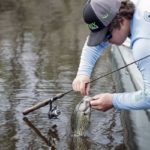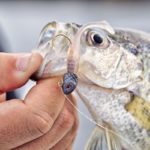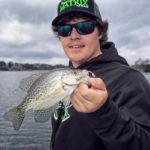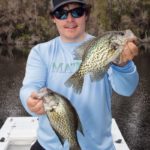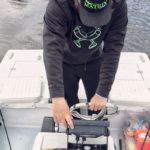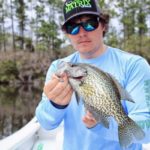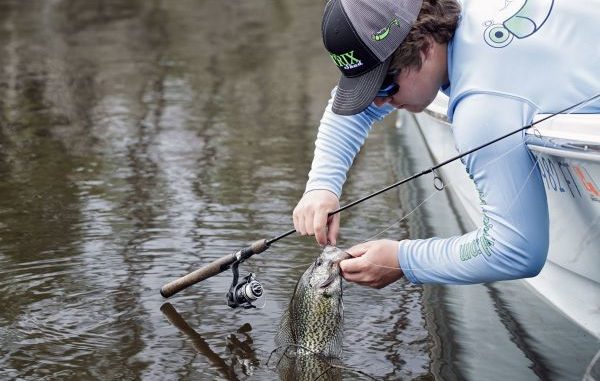
Weather can keep you off the water this month, but this crappie angler said that’s a big mistake — as long as you know where the fish can be found. Learn his proven tactic for filling the boat with sac-a-lait.
It didn’t take long for Ty Hibbs to stop paying attention to me. Our conversation came to an abrupt stop as soon as we left the ramp.
Rather than listening to me, his eyes and mind became fixated on his fish finder.
Only, he wasn’t looking for fish.
“Trying to find the fuzz,” he mumbled.
I would have thought he would be trying to find the fish, but what do I know?
“I got plenty in my belly button,” I told him.
He wasn’t listening.
Then he started looking for lava.
I was sharing the boat with a man acting like he had not gone to bed until 2 a.m. I forced him to explain what he was babbling about.
Hibbs began to explain why he was looking for fuzz and lava.
“Back some time ago, I was fishing a cork on a gum tree at Des Allemands and not catching many sac-a-lait,” he said. “Out in the middle of the canal, there was a man fishing out of an old, banged-up boat.”
The boat was so beat up that Hibbs couldn’t help but think the depth finder the old man kept looking at had to have cost more than his boat.
“He was smoking the sac-a-lait,” Hibbs said, “and he wound up telling me a little later to look at my depth finder to find the fuzz on bottom.”
That was the first time Hibbs had ever thought much about a fish finder other than maybe using one to find a 20-foot ledge in Lake Pontchartrain or Bayou Bienvenue.
However, since that fateful day when he got schooled in the back of a dead-end canal at Des Allemands, Hibbs has committed himself to learning how to use his fish finder to find deep schools of sac-a-lait.
“It’s kind of like offshore tuna fishing,” he said, “but you’ve got to turn your sensitivity way up because the fish are so much smaller.”
If the bait is on the bottom, Hibbs said it will look like a bunch of fuzz on the bottom of your screen. And if sac-a-lait are anywhere around the bait, they’ll appear as little boomerangs almost like little yellow balls.
“At least that’s what they look like on a Lowrance,” Hibbs said. “Depending on how big the school is, they’ll just cover up the bottom, and look like yellow and orange globs of lava spilling all over your screen.”
Hibbs continued to monitor his Lowrance as he idled away from the ramp. At least now I knew what he was doing —even if I didn’t quite understand it.
“Come here and I’ll show you,” he said.
I followed his pointing finger to a spot on the bottom of the screen, and danged if he wasn’t pointing to a bunch of fuzz on bottom surrounded by what looked to be a tipped-over lava lamp.
Almost as an afterthought, Hibbs grabbed a small spinning rod and tossed out 1/8-ounce jigged with a new, prototype Matrix Mini threaded on it.
Seconds later, his rod tip ticked one time, and Hibbs was reeling our first fish into the boat.
“When you find the fuzz, the main thing is to get a bait — a bunch of baits — in the water as quickly as possible to make sure what you’re seeing is fish,” he explained. “Since most fish-finder transducers are on the transom, make sure to make a quick cast out the back.”
After catching a few more crappie, Hibbs tossed an orange marker buoy into the water so we could stay on the school and work it for all it was worth.
“If we only caught one, I might not have stuck around,” he said. “But since they look like they’re hungry, we might as well stick around and whack on them a while.”
The orange buoy came in extremely handy for helping us cast to the same spot over and over again. Even in small water with many reference points on the bank, it’s easy to get off track just enough to keep your baits from running through exactly where they need to.
“And don’t just cast one way,” Hibbs advised. “Come at the fish from a bunch of different angles. I’ve heard things about sac-a-lait all facing one direction and not eating a bait that ran up from behind them.
“You never know which angle will be like flipping a switch, so keep trying until you get them to bite or you’re confident they’re not going to.”
To make sure his Matrix Minis were staying on the bottom where the sac-a-lait were, Hibbs threaded his baits onto 1/8-ounce jigheads, which might seem a little heavy for sac-a-lait.
“I like the 1/8(-ounce jigs) to get it down a little bit faster,” Hibbs said. “One-sixteenth is good, too, but it’s a little bit harder to jig it because it’s so hard to feel. I always tell people that if they are having trouble feeling the bottom to tie on two jigheads.
“You might not catch a bunch of doubles, but it’s a great way to learn how to feel the bottom.”
The more we fished, the more I realized exactly what Hibbs was doing to get bit. Although he verbally wished many times to try a multi-pole spider rig one day, he was fishing these sac-a-lait just like he would fish for speckled trout in Lake Pontchartrain.
In other words, rather than suspending his bait at the exact depth of the fish or slightly above them as is often the best strategy for sac-a-lait, he was allowing his bait to hit bottom before hopping it up and down.
“If you see fuzz on bottom you better get your bait on bottom,” he insisted. “If they’re on bottom in 24 feet of water, you better be on bottom in 24 feet of water.
“Now, if you see something on your fish finder that looks more like a Christmas tree than balls of lava, then you’re going to want to count it down to that depth, and then swim and jig it.”
And, wouldn’t you know it, just about the time Hibbs described sac-a-lait stacked up like Christmas trees, I looked at his Lowrance and saw exactly that scenario.
“That’s probably why the bite has slowed down,” Hibbs said. “First thing this morning, they were right on bottom. Now that it’s warmed up, they’re suspending a little bit to stay close to the bait.”
Once he realized that the sac-a-lait were about 12 feet deep rather than on the bottom, Hibbs started swimming his lure right at that depth, and the bite turned on again.
Although finding the fuzz and deep-jigging sac-a-lait sounds like it would apply more to big lakes like Toledo Bend and Lake D’Arbonne than it would the backwater bayous of South Louisiana, Hibbs said he uses this same method to catch fish at Des Allemands and Lake Cataouatche.
“Des Allemands is good for all this stuff because it’s more of a deepwater thing,” Hibbs said. “But you can do it at Cataouatche, too. Places like the Gulf Canals and in Segnette there are 10- to 15-foot(-deep) canals. I don’t fish them as much because Des Allemands is so good, but you can catch them over there.
“All you’ve got to do is find 15 feet of water — doesn’t matter where it is.”
Regardless of where he fishes, Hibbs approaches his find-the-fuzz philosophy exactly the same way.
After launching off any of the rivers and bigger canals where the water is dirty, he starts looking for root beer-colored, blacker water.
“Obviously, the first thing I do is look for dead-end canals,” Hibbs said. “Even in April, anything that goes to a dead end can be good — not so much the through canals.”
Once he finds clear water, Hibbs turns on his electronics and starts looking for fuzz.
“In Des Allemands, a lot of canals where I find fish are anywhere from 10 to 12 feet deep — some maybe even 15 feet,” Hibbs said. “And if you can find 20 feet in the back end of a canal, that’s a great place to target.”
At the marshy side of Cataouatche, Hibbs looks for shallower canals in the 8-foot-deep range.
As we moved on in search of another school of sac-a-lait, Hibbs told me one of the main reasons he likes to fish deep schools is that he feels he’s fishing a virtually untapped resource.
“A lot of Louisiana sac-a-lait anglers just put a minnow about a foot under a cork and go fishing,” he said. “You can’t do that in January, February, March or even the cold days in April.
“When it’s cold, they want a bait on bottom, and my best approach is to fish from the bottom up rather than the top down.”
Hibbs’ bottom-up approach puts him on the fish faster, especially on high-pressure days when he feels his only shot at catching them is fishing the bottom in deep water.
He also likened it to learning how to fish speckled trout in Lake Pontchartrain.
“Somebody will go out (to Pontchartrain) and try to figure it out, but they don’t catch anything and wind up leaving,” Hibbs said. “They probably got a lot of bites but just didn’t realize it. This deep sac-a-lait fishing is the same way: Some people try it once but head back shallow after they get frustrated.”
Hibbs also stacks the odds in his favor by fishing on days when other anglers might not even get out of bed.
“Don’t roll over and go back to sleep just because it looks like rain or a front is coming through,” he explained. “In fact, it’s just the opposite: You better be getting up early on those kinds of days.
“Fish until the front blows through — the nastier the conditions the better those sac-a-lait are going to bite.”
Being one who might have given up had I not been in the boat with Hibbs, I stuck with it long enough to figure out how to jig up some deep sac-a-lait of my own.
I found the fuzz and got a Matrix Mini down to the sac-a-lait.
After that, it didn’t take long for me to stop paying attention to Hibbs.
